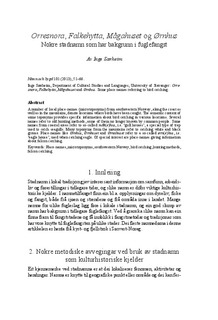| dc.contributor.author | Særheim, Inge | |
| dc.date.accessioned | 2014-12-04T09:26:19Z | |
| dc.date.available | 2014-12-04T09:26:19Z | |
| dc.date.issued | 2013 | |
| dc.identifier.citation | Særheim, I. (2013) Orresnora, Falkehytta, Mågahuset og Ørnhus: nokre stadnamn som har bakgrunn i fuglefangst, Namn och bygd, 101, pp. 51-66 | nb_NO |
| dc.identifier.issn | 0077-2704 | |
| dc.identifier.uri | http://hdl.handle.net/11250/226713 | |
| dc.description | Artikkelen har tidligere stått på trykk i tidsskriftet Namn och bygd, vol. 101, 2013, og gjengis her med tillatelse fra forlaget. Se http://www.kgaa.nu/tidskrift.php?id=4 | nb_NO |
| dc.description.abstract | A number of local place-names (microtoponyms) from southwestern Norway, along the coast as
well as in the mountains, denote locations where birds have been caught. The semantic content of
some toponyms provides specific information about bird catching in various locations. Several
names refer to old hunting methods, some of them no longer known by common people. Some
names from coastal areas refer to so-called måk(e)hus, i.e. ‘gull houses’, a special type of trap
used to catch seagulls. Many toponyms from the mountains refer to catching white and black
grouse. Place-names like Ørnhus, Ørnhuset and Ørnahuset refer to a so-called ørn(e)hus, i.e.
‘eagle house’, used when catching eagle. Of special interest are place-names giving information
about falcon catching. | nb_NO |
| dc.language.iso | nno | nb_NO |
| dc.publisher | Kungl. Gustav Adolfs akademien för svensk folkkultur | nb_NO |
| dc.subject | stedsnavn | nb_NO |
| dc.subject | mikrotoponymer | nb_NO |
| dc.subject | sørvest Norge | nb_NO |
| dc.subject | fuglefangst | nb_NO |
| dc.title | Orresnora, Falkehytta, Mågahuset og Ørnhus: nokre stadnamn som har bakgrunn i fuglefangst | nb_NO |
| dc.type | Journal article | nb_NO |
| dc.subject.nsi | VDP::Humanities: 000::Linguistics: 010::Nordic languages: 018 | nb_NO |
| dc.source.pagenumber | 51-66 | nb_NO |
| dc.source.volume | 101 | nb_NO |
| dc.source.journal | Namn och bygd | nb_NO |
